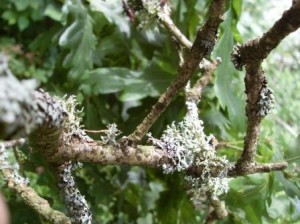Likin’ the lichen
Lichen can be found in a huge variety of places, from rocks and tree trunks, to volcanoes and arctic tundra.
But what is it? Is it a plant, fungus or an animal? Well, this little phrase my Dad told me is a good reminder: Annie alga and Freddie fungus took a likin’ to each other.
Lichen is made up of two living things, algae and fungi, which live together in a symbiotic relationship. The definition of this is a close and long term interaction between different biological species, which is mutually beneficial to both.
The fungus does its bit by retaining water which protects the alga, which can only live in wet conditions. The alga is photosynthetic, meaning, like a plant, it can turn carbon dioxide in to sugars, which feeds both the alga and the fungus.

There are many different species of lichen, each with a different tolerance to air pollution, so studying the types of lichen growing in a particular area indicate the level of air pollution.
Lichens can also be used to tell the age of exposed rock surfaces, which can help with working out when geological features were formed. This is done by measuring their size. As lichens grow outwards at specific rates, scientists can measure this very accurately. Lichens can be preserved for up to 10 000 years on rock, so can provide information on ages of rock surfaces within that time.
Bye for now,
Rhian – Seasonal Ranger
Help protect Scotland’s wildlife
Our work to save Scotland’s wildlife is made possible thanks to the generosity of our members and supporters.
Join today from just £3 a month to help protect the species you love.
Preface
Lichen can be found in a huge variety of places, from rocks and tree trunks, to volcanoes and arctic tundra. But what is it? Is it a plant, fungus or …
